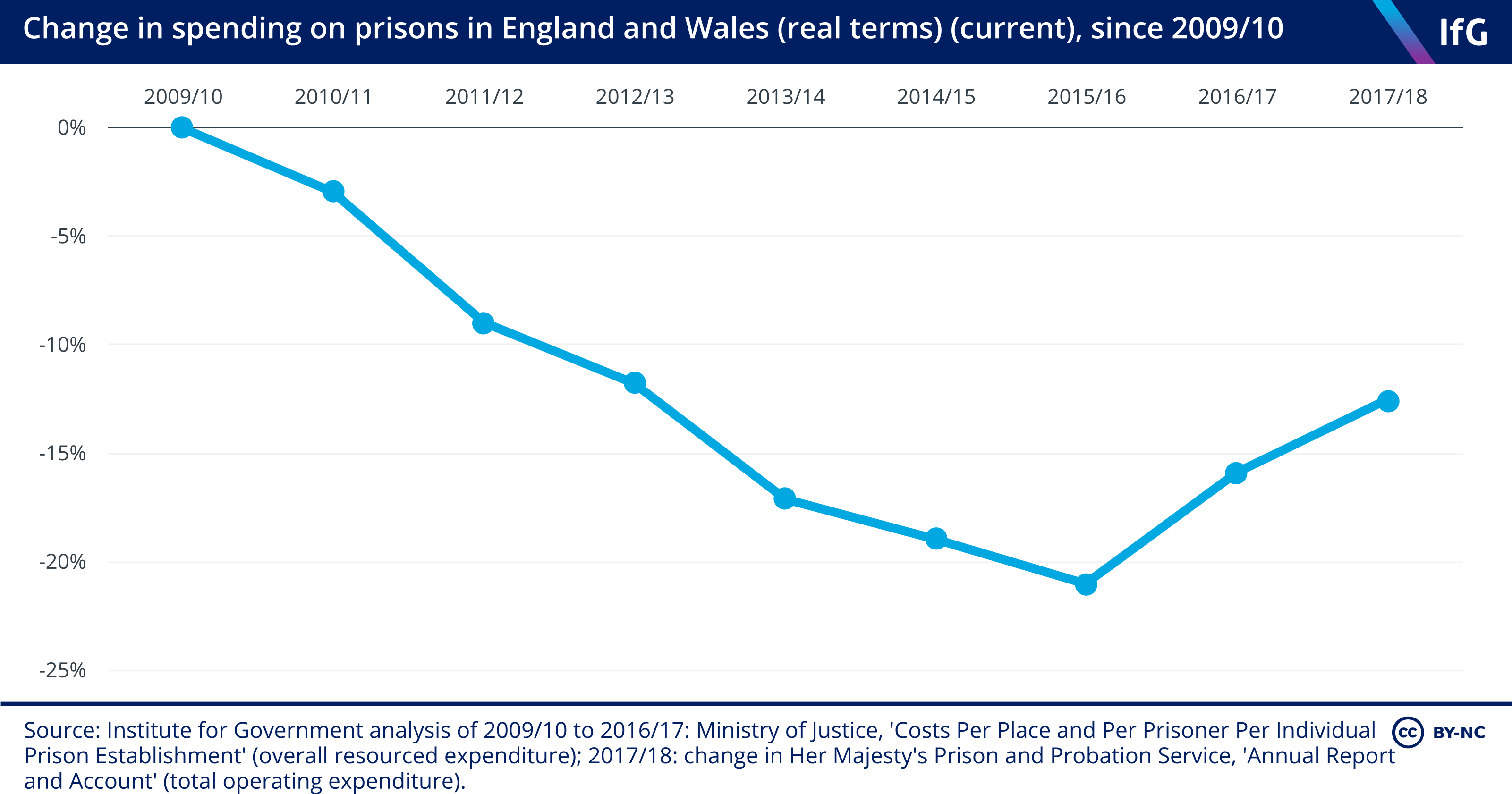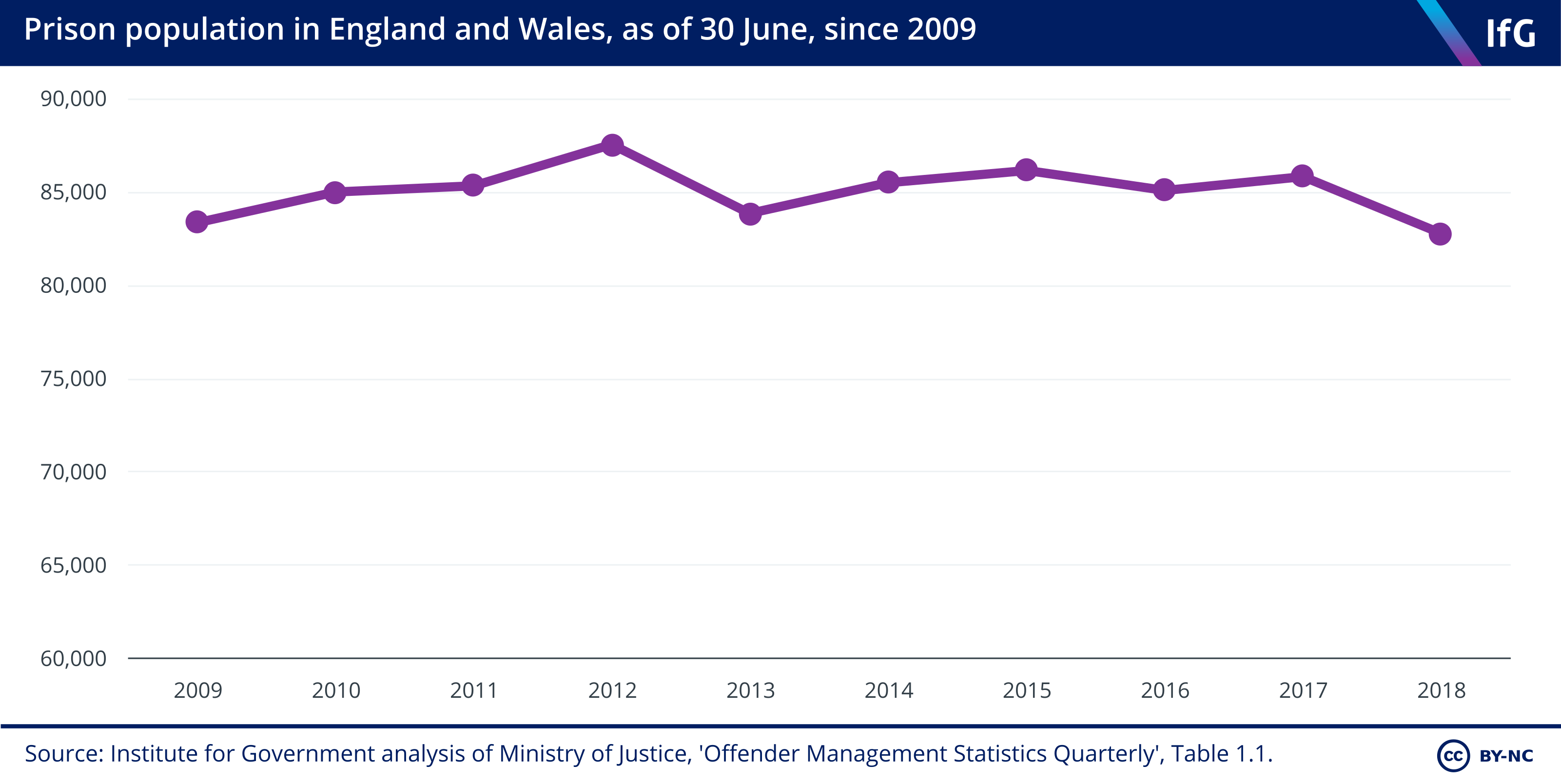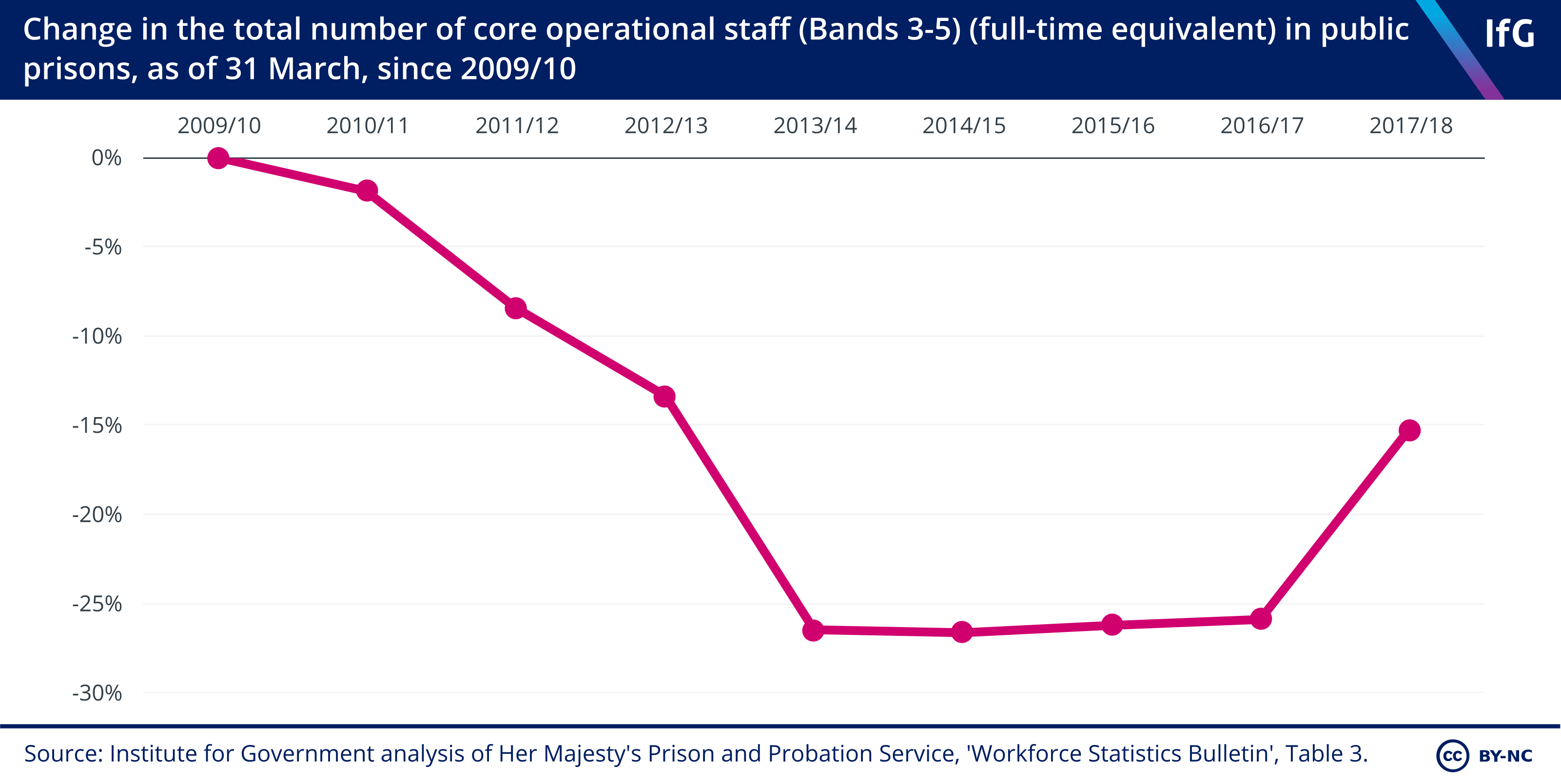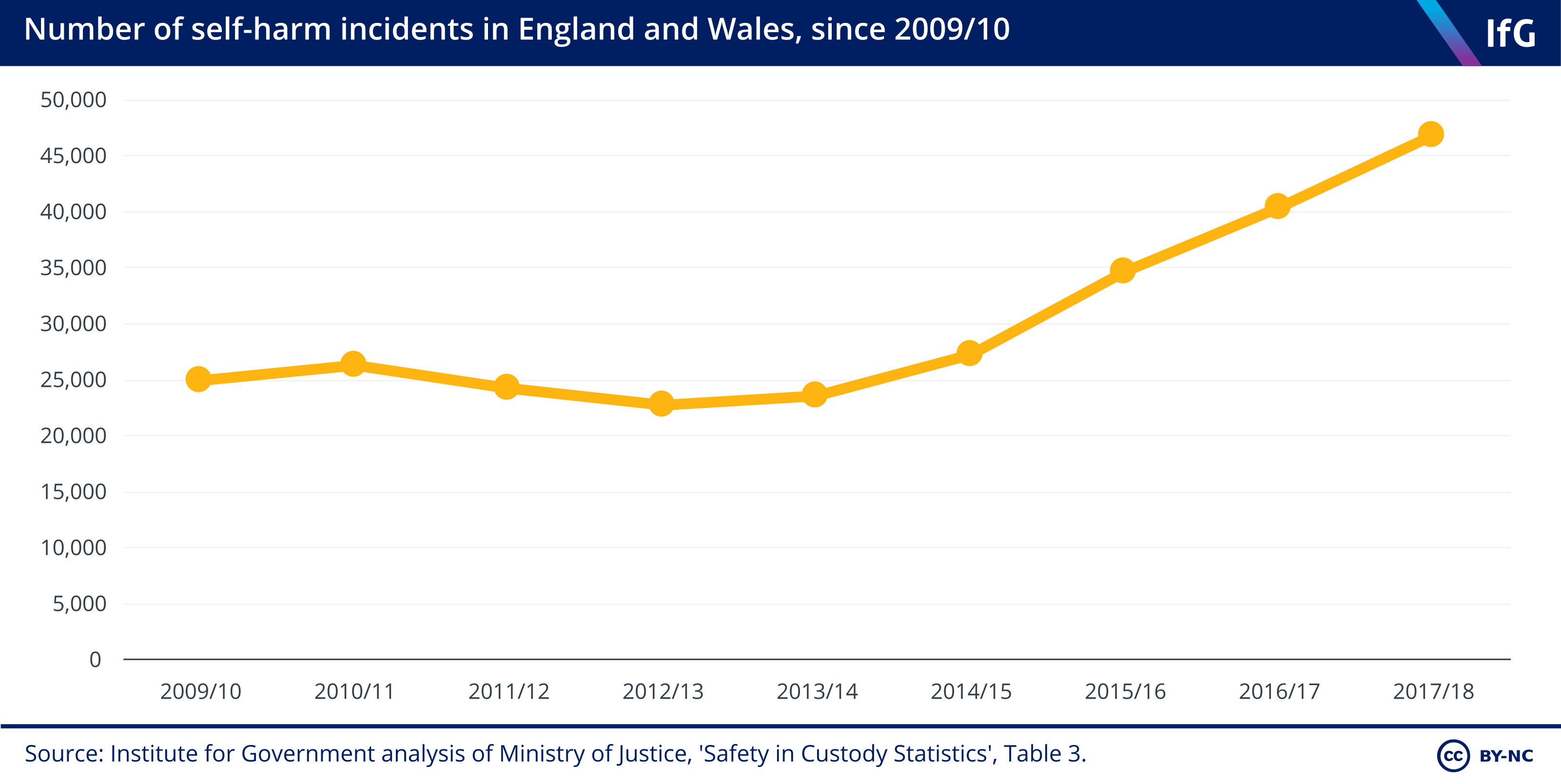Prisons - 10 Key Facts

Prisons have experienced large spending cuts and cuts to staff numbers since 2009/10. Despite promising signs in the early years of this period that this was manageable, in 2013/14 prison safety started to deteriorate sharply. Violence rates have risen, and prisoners appear to have less access to learning and development activities.
Spending has risen recently following an injection of extra cash at the 2016 Autumn Statement to tackle the decline in prison safety. The rates of deaths in prison has subsequently fallen, but the data does not yet show any discernible improvements in overall violence levels.
For full citations and further details, see the prisons chapter from Performance Tracker 2018. This analysis is drawn from Performance Tracker, produced by the Institute for Government in partnership with CIPFA.
1. Day-to-day spending on prisons fell by 21% in real terms between 2009/10 and 2015/16.
- Extra money was pumped into the prison system, after a riot in Birmingham prison brought public attention to problems with the system. The 2016 Autumn Statement announced £291m over three years.
- But spending is still lower than it was eight years ago. In 2017/18, around £3.2bn was spent on prisons; 13% less in real terms than in 2009/10.
2. The size of the prison population has not changed very much.
- On 30 June 2018, there were 82,773 prisoners in England and Wales compared with 83,391 on 30 June 2009.
- Prisoners are mostly male. The prison population is consistently around 95% male.
- There are fewer young people in custody. Between June 2010 and June 2018, the number of under-18s in young offender institutions more than halved from 1,661 to 642 (all male). While there has been a fall in youth crime, the proportion of young people being held for violent offences is growing.
3. But the prison population is getting older, and harder to deal with.
- Since 2016 there has been a 16% rise in the number of people in prison aged 70 and over. This means there is growing demand for care in prisons.
- A large share of the prison population has a mental illness. The data is incomplete, but estimates range between 23% and 37% of prisoners with a mental health problem. This may be higher than the prevalence of mental illness in the general population – estimated to be 23% in 2007.
- New drugs like ‘spice’ – which can induce psychosis and aggression – are also putting pressure on prisons. They are also very prevalent. In 2017/18, 10.1% of mandatory drug tests were positive for the use of new psychoactive substances, compared with 10.3% positive drug test for all other drugs.
4. Private prisons house nearly 20% of the prison population.
- There are only 14 ‘private prisons’ (operated by private companies on behalf of the state), compared with 122 ‘public’ prisons (run directly by Her Majesty’s Prison and Probation Service) – but they tend to be larger.
- Since 2009/10, 20 prisons have closed or merged and five new prisons have opened. Only one new prison has been initiative and built since 2009/10: Berwyn in North Wales was announced in 2013 and began to receive prisoners in February 2017.
- But the overall capacity of the prison system is roughly the same. This is due to the larger size of the new prisons.
5. The number of prison officers dropped by a quarter between 2009/10 and 2013/14.
- In 2013/14 alone, prison officer numbers (FTE) fell by 15% (3,250 officers) – equalling the reductions seen in total over the previous four years.
- But recently the number has risen. Since March 2017, the number of prison officers has risen by 3,205, a 17% increase. In June 2018, there were 21,608 FTE prison officers in public prisons.
6. In June 2018, a third of prison officers had less than two years' experience, compared with 7% in March 2010.
- Despite improved recruitment, retention of prison officers is weak and turnover is high. In 2016/17, 4,933 new prison officers joined the prison service, while 2,088 left.
- Other parts of the prison workforce have continued to shrink. The number of prison managers has fallen from 1,434 in March 2010 to 905 in June 2018 (a 37% decrease).
- Prison officers are starting to see their pay rise. Pay was frozen between 2011/12 and 2012/13, and increases were subsequently capped at 1% a year. But prison officers received a 1.7% pay rise for the 2017/18 financial year – and have been awarded a 2.75% increase for 2018/19.
7. In 2017/18, there were more than 9,000 assaults on prison staff (106 for every 1,000 prisoners).
- Prisons are increasingly more dangerous for prisoners and staff. The frequency of assaults has almost tripled since 2009/10, both in raw and per-prisoner terms.
- The violence against staff is intensifying. There was a 26% increase in assaults on prison staff in the past year alone. The frequency of serious assaults against staff has risen even faster – from 289 (three for every 1,000 prisoners) in 2009/10 to 892 (10 for every 1,000 prisoners) in 2017/18.
8. There were 22,374 prisoner-on-prisoner assaults in 2017/18.
- This is nearly double the number that took place in 2009/10. Serious assaults against prisoners has also risen more rapidly: from 1,087 in 2009/10 to 3,081 in 2017/18.
- And the violence among youth offenders is more intense. Across the whole youth estate, there were 2.77 assaults per prisoner in 2017/18, up from 1.84 in 2012/13 (although the size of the youth estate has shrunk rapidly in this time).
- These are likely to be underestimations. A government audit of data collection practices in prisons last year found that assaults were underreported by 10% the previous year.
9. The number of self-harm incidents rose by 88% (from just under 25,000 to just under 47,000) between 2009/10 and 2017/18.
- These incidents were gendered. There were 2,244 self-harm incidents for every 1,000 female prisoners compared with 467 for every 1,000 male prisoners. The gender differential was much smaller among assault incidents: there were 366 assaults for every 1,000 male prisoners in 2017/18 and 318 for every 1,000 female prisoners.
- Self-inflicted deaths are becoming less frequent. After a big increase in 2015/16 and 2016/17, self-inflicted deaths in prisons fell in 2017/18 to their lowest levels since 2012/13. However that still amounted to 69 self-inflicted deaths (0.8 for every 1,000 prisoners).
10. Only 16% of prisoners were unlocked for the recommended 10 hours a day in 2017/18.
- That means that prisoners have limited access to meaningful activity that might support them on release.
- There’s been a decline in prisoners achieving academic qualifications. In 2016/17, 6,750 prisoners achieved a level 1 or 2 (pre-GCSE and GCSE-level) qualification in England, down from 11,760 in 2010/11 (a 43% decline). The number achieving a level 1 or 2 in maths fell from 10,950 to 6,800 (a 38% decline).
- Fewer prisoners are starting and completing accredited courses that may support them on release. The number of prisoners completing these programmes has fallen by 22% since 2014/15 (from 6,994 to 5,479).
- Topic
- Public services




